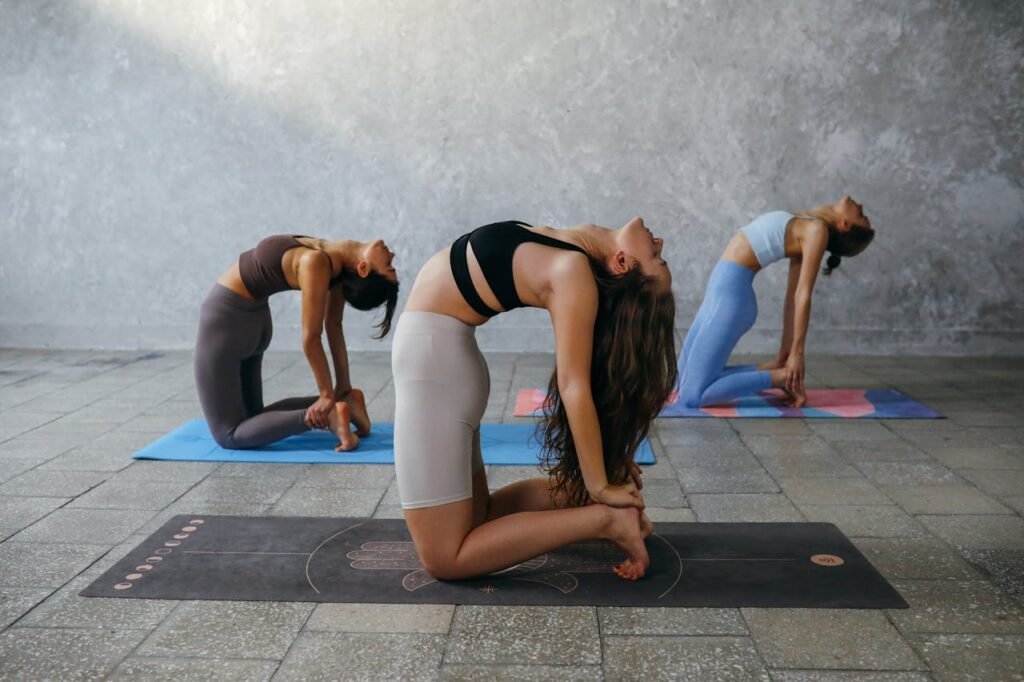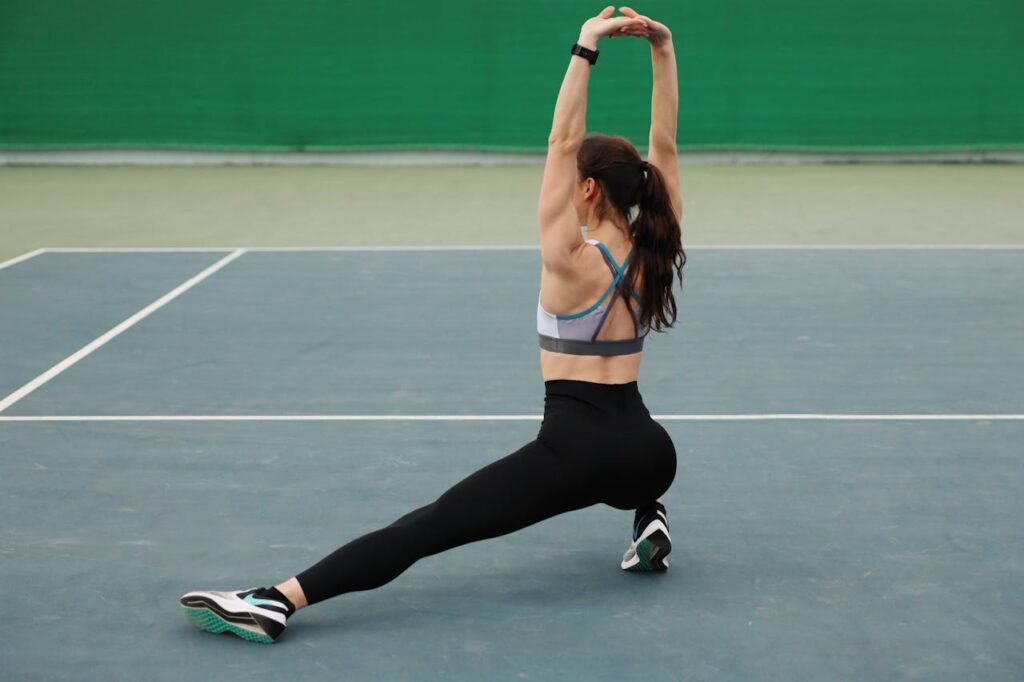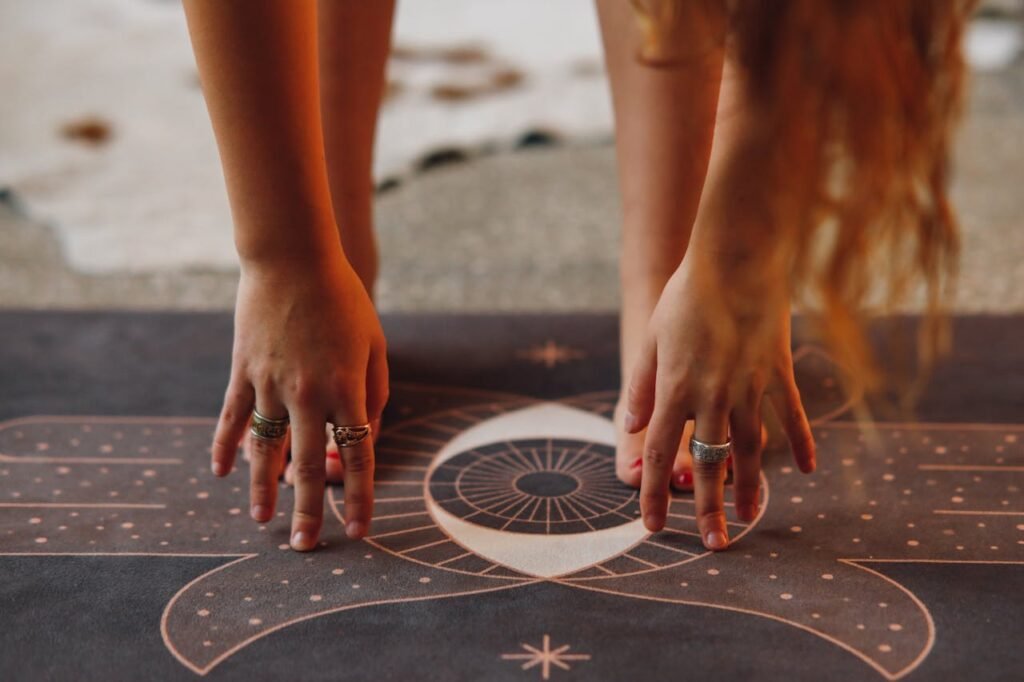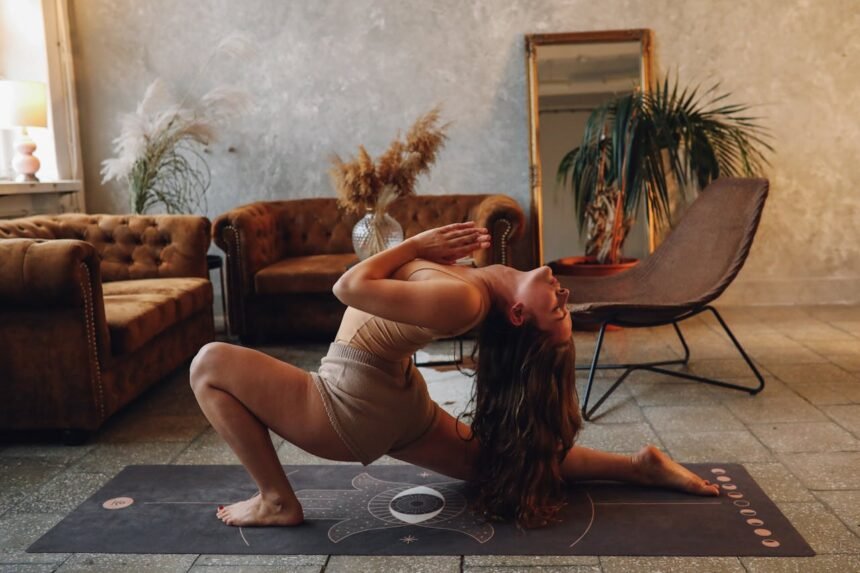Discover the ultimate guide to relieving neck and shoulder tension with our comprehensive article on trap stretches. This in-depth exploration covers 9 essential exercises designed to target your trapezius muscles, promoting flexibility, reducing pain, and improving overall upper body comfort.
From simple neck rotations to yoga-inspired poses like Child’s Pose and Thread the Needle, we break down each stretch with easy-to-follow instructions, key tips, and pro advice. Learn when and how to incorporate these stretches into your daily routine for maximum benefit. Whether you’re battling desk job stiffness, recovering from workouts, or simply seeking better posture, this article has you covered.
Complete with a quick reference table and FAQ section, it’s your one-stop resource for understanding and implementing effective trap stretches. Say goodbye to nagging upper body tension and hello to a more relaxed, flexible you!
Introduction
Trap stretches are a game-changer when it comes to relieving neck and shoulder tension. If you’ve ever experienced that nagging tightness in your upper back or the stiffness that comes from hunching over a desk all day, you’re not alone. The trapezius muscle, commonly known as the “traps,” is often the culprit behind this discomfort. But fear not! With the right set of trap stretches, you can bid farewell to that persistent tension and hello to a more relaxed, flexible upper body.
In this comprehensive guide, we’ll explore nine essential trap stretches that can help you alleviate neck and shoulder tension, improve your posture, and enhance your overall well-being. Whether you’re an office warrior, a fitness enthusiast, or someone who simply wants to feel more comfortable in their own skin, these trap stretches are for you.
So, let’s dive in and discover how these simple yet effective exercises can transform your upper body comfort and flexibility. Get ready to stretch those traps and release the tension that’s been holding you back!
Understanding the Trapezius Muscle
Before we jump into our trap stretches, let’s take a moment to understand the star of the show: the trapezius muscle. This large, triangular muscle spans across your upper back, neck, and shoulders, playing a crucial role in various movements and postural support.
The trapezius is divided into three main sections:
- Upper trapezius: Runs from the base of your skull to your shoulders
- Middle trapezius: Spans horizontally across your upper back
- Lower trapezius: Extends down your mid-back
Each section has its own unique function:
- The upper traps help with shoulder elevation and neck extension
- The middle traps assist in retracting your shoulder blades
- The lower traps aid in depressing your shoulder blades
When we talk about trap stretches, we’re often focusing on the upper and middle sections, as these are the areas most prone to tension and tightness. However, a well-rounded stretching routine will address all parts of this important muscle group.
Common causes of trapezius tension include:
- Poor posture (hello, desk jobs!)
- Stress and anxiety
- Repetitive movements
- Carrying heavy bags
- Sleeping in awkward positions
By incorporating regular trap stretches into your routine, you can counteract these daily stressors and maintain a healthier, more flexible upper body. Remember, a happy trapezius means a happier you!
Benefits of Regular Trap Stretches
Before we dive into the specific exercises, let’s talk about why trap stretches are so beneficial. Trust me, once you know the perks, you’ll be itching to get stretching!
- Pain Relief: Trap stretches can significantly reduce neck and shoulder pain by releasing tension in the muscles.
- Improved Posture: Regular stretching can help correct postural imbalances, leading to a more upright and confident stance.
- Increased Range of Motion: Loosening tight traps can enhance your neck and shoulder mobility, making everyday movements easier.
- Stress Reduction: Stretching can help release physical and mental tension, promoting relaxation and stress relief.
- Headache Prevention: Many tension headaches originate from tight neck and shoulder muscles. Trap stretches can help keep these at bay.
- Better Sleep: Releasing tension in your upper body can lead to more comfortable sleep positions and improved sleep quality.
- Enhanced Athletic Performance: For the fitness enthusiasts out there, flexible traps can improve your form and reduce the risk of injury during workouts.
- Improved Circulation: Stretching promotes blood flow to the muscles, which can aid in recovery and overall muscle health.
- Increased Body Awareness: Regular stretching helps you tune into your body, making you more aware of areas of tension or imbalance.
Remember, consistency is key when it comes to reaping the benefits of trap stretches. Aim to incorporate these exercises into your daily routine for the best results. Your neck and shoulders will thank you!
Now that we’ve covered the why, let’s move on to the how. Get ready to learn nine essential trap stretches that will revolutionise your upper body comfort!
1. Trap Stretches: Neck Rotation
Let’s kick off our trap stretches with a simple yet effective exercise: neck rotation. This stretch targets the upper trapezius and can provide immediate relief from neck tension.
How to perform neck rotation:
- Start in a seated or standing position with your back straight and shoulders relaxed.
- Slowly turn your head to the right, bringing your chin towards your right shoulder.
- Hold for 15-30 seconds, feeling the stretch along the left side of your neck.
- Gently return to the centre.
- Repeat on the left side, turning your head to bring your chin towards your left shoulder.
- Hold for 15-30 seconds.
- Perform 2-3 repetitions on each side.
Key points to remember:
- Keep your shoulders relaxed throughout the stretch. Resist the urge to hunch them up towards your ears.
- Move slowly and gently. This isn’t a race!
- Breathe deeply and evenly to enhance the stretch and promote relaxation.
When to do this stretch:
- First thing in the morning to release nighttime tension
- During work breaks to combat the effects of prolonged sitting
- After workouts to cool down and prevent stiffness
Pro tip: If you’re dealing with particularly stubborn neck tension, try combining this stretch with gentle self-massage. Use your fingertips to apply light pressure to any tight spots you feel along your neck as you rotate.
Remember, consistency is key with trap stretches. Make neck rotation a regular part of your routine, and you’ll be on your way to a more relaxed, flexible neck in no time!

2. Trap Stretches: Shoulder Shrugs and Rolls
Next up in our trap stretches repertoire are shoulder shrugs and rolls. These simple movements target the entire trapezius muscle, from the base of your skull to your mid-back. They’re perfect for releasing tension and improving circulation in your shoulder area.
Let’s break it down:
Shoulder Shrugs:
- Stand or sit with your back straight and arms relaxed at your sides.
- Slowly lift your shoulders towards your ears, as high as you comfortably can.
- Hold for 3-5 seconds, feeling the contraction in your trapezius muscles.
- Slowly lower your shoulders back down, focusing on releasing all tension.
- Repeat 10-15 times.
Shoulder Rolls:
- From the same starting position, slowly roll your shoulders forward in a circular motion.
- Make the circles as large as comfortably possible.
- Perform 10 forward rolls, then reverse the direction.
- Do 10 backward shoulder rolls.
Key points to remember:
- Keep your movements slow and controlled. This isn’t a race!
- Focus on your breath. Inhale as you lift or roll forward, exhale as you lower or roll backward.
- Pay attention to any areas of tightness or discomfort, but avoid pushing into pain.
When to do these trap stretches:
- As part of your morning routine to wake up your upper body
- During work breaks to combat the effects of prolonged sitting
- Before workouts as a warm-up for your upper body
Pro tip: For an extra challenge, try doing shoulder shrugs while holding light dumbbells. This can help strengthen your traps while also stretching them.
Remember, these trap stretches are all about quality, not quantity. Focus on performing each movement with intention and awareness. Your shoulders will thank you for the extra attention!
3. Trap Stretches: Upper Trapezius Stretch
Now, let’s focus on one of the most effective trap stretches for targeting that pesky upper trapezius tension: the upper trapezius stretch. This exercise directly addresses the area between your neck and shoulders, which is often tight due to poor posture or stress.
Here’s how to do it:
- Start by sitting or standing with your back straight and shoulders relaxed.
- Reach your right hand over your head and place it on the left side of your head, above your ear.
- Gently pull your head to the right side, bringing your right ear towards your right shoulder.
- To intensify the stretch, use your left hand to gently pull your left shoulder down and away from your ear.
- Hold this position for 15-30 seconds, feeling the stretch along the left side of your neck and upper shoulder.
- Slowly release and return to the starting position.
- Repeat on the other side, placing your left hand on the right side of your head and pulling towards your left shoulder.
- Perform 2-3 repetitions on each side.
Key points to remember:
- Keep your shoulders relaxed throughout the stretch. Resist the urge to hunch them up.
- The movement should be gentle and controlled. Never force the stretch beyond your comfortable range of motion.
- Breathe deeply and evenly, which can help enhance the effectiveness of the stretch and promote relaxation.
When to do this stretch:
- As part of your morning routine to release nighttime tension
- During work breaks, especially if you spend a lot of time at a desk or computer
- After workouts to cool down and prevent stiffness in the neck and shoulders
Pro tip: For an extra deep stretch, try performing this exercise while seated on your hand. This will help anchor your shoulder down, allowing for a more intense stretch in the upper trapezius.
Remember, consistency is key with trap stretches. Make the upper trapezius stretch a regular part of your routine, and you’ll be amazed at how much more relaxed and flexible your neck and shoulders can feel!
4. Trap Stretches: Levator Scapulae Stretch
Next in our lineup of trap stretches is the levator scapulae stretch. While not technically part of the trapezius, the levator scapulae muscle works closely with the upper traps and is often a source of neck and upper shoulder tension. This stretch targets the muscle that runs from the upper shoulder blade to the top of the neck.
Here’s how to perform the levator scapulae stretch:
- Start by sitting or standing with your back straight and shoulders relaxed.
- Turn your head approximately 45 degrees to the right, so you’re looking towards your right armpit.
- Tilt your head forward, bringing your chin down towards your chest.
- To deepen the stretch, place your right hand on the back of your head and gently apply pressure, pulling your head further down and forward.
- Hold this position for 15-30 seconds, feeling the stretch along the left side of your neck and upper shoulder blade area.
- Slowly release and return to the starting position.
- Repeat on the other side, turning your head 45 degrees to the left and tilting forward.
- Perform 2-3 repetitions on each side.
Key points to remember:
- Maintain proper posture throughout the stretch, keeping your back straight and shoulders relaxed.
- The movement should be gentle and controlled. Never force the stretch beyond your comfortable range of motion.
- Focus on your breath, taking deep, even breaths to enhance relaxation and the effectiveness of the stretch.
When to do this stretch:
- In the morning to release any tension built up during sleep
- During work breaks, especially if you spend a lot of time looking at screens
- After physical activities that involve repetitive neck movements
Pro tip: If you’re having trouble finding the right angle for this stretch, imagine you’re trying to look at a name tag pinned to your shirt at your armpit. This visual cue can help you achieve the correct head position.
Remember, the levator scapulae stretch is a powerful addition to your trap stretches routine. By giving attention to this often-overlooked muscle, you can significantly reduce neck and upper shoulder tension. Your neck will thank you for the extra TLC!
5. Trap Stretches: Cat-Cow Pose
Moving on to a more dynamic stretch in our trap stretches series, let’s explore the Cat-Cow pose. This yoga-inspired movement not only stretches the trapezius but also provides a gentle stretch for the entire spine, making it a fantastic all-rounder for upper body tension relief.
Here’s how to perform the Cat-Cow pose:
- Start on your hands and knees in a tabletop position. Your wrists should be directly under your shoulders, and your knees under your hips.
- Begin with the Cow pose: As you inhale, drop your belly towards the mat. Lift your chin and chest, and gaze up toward the ceiling.
- Draw your shoulders away from your ears.
- Now move into the Cat pose: As you exhale, draw your belly to your spine and round your back toward the ceiling.
- Release the top of your head toward the floor, but don’t force your chin to your chest.
- Inhale, coming back into Cow pose.
- Repeat this flowing movement 5-10 times.
Key points to remember:
- Focus on the movement of your spine and how it affects your trapezius muscles.
- Keep your movements slow and controlled, synchronizing them with your breath.
- Don’t force your body into positions that feel uncomfortable or painful.
When to do this stretch:
- As part of your morning routine to wake up your spine and release nighttime tension
- During work breaks to counteract the effects of sitting
- Before or after workouts as part of your warm-up or cool-down routine
Pro tip: To focus more on your trapezius muscles during this stretch, pay extra attention to the shoulder blade movement. As you move into Cow pose, focus on squeezing your shoulder blades together. In Cat pose, focus on spreading them apart.
The Cat-Cow pose is a wonderful addition to your trap stretches routine. Not only does it help relieve tension in your trapezius muscles, but it also promotes spinal flexibility and can help improve your overall posture. Give it a try and feel the difference in your upper body!
6. Trap Stretches: Thread the Needle
Next up in our trap stretches series is a yoga-inspired move called “Thread the Needle.” This stretch is particularly effective for targeting the middle and upper trapezius, as well as the rhomboids and rotator cuff muscles. It’s a fantastic way to release tension in the upper back and shoulders.
Here’s how to perform the Thread the Needle stretch:
- Start on your hands and knees in a tabletop position, with your wrists under your shoulders and knees under your hips.
- Lift your right hand off the ground and slide it under your left arm, palm facing up.
- Lower your right shoulder and the side of your head to the ground, keeping your left arm straight for support.
- You should feel a stretch across your upper back and between your shoulder blades.
- Hold this position for 15-30 seconds, breathing deeply.
- Slowly return to the starting position.
- Repeat on the other side, threading your left arm under your right.
- Perform 2-3 repetitions on each side.
Key points to remember:
- Keep your hips stacked over your knees throughout the stretch.
- Don’t force your shoulder or head to the ground if it’s uncomfortable. Go only as far as feels good for your body.
- Focus on breathing deeply into the stretch, which can help release tension more effectively.
When to do this stretch:
- As part of your morning yoga or stretching routine
- After long periods of sitting or computer work
- Following upper body workouts to help release tension in the shoulders and upper back
Pro tip: To deepen the stretch, try extending the top arm (the one not threaded) straight up towards the ceiling. This creates a gentle twist in the spine, which can provide an extra release for the trapezius muscles.
The Thread the Needle stretch is a wonderful addition to your trap stretches routine. It not only helps relieve tension in the trapezius but also promotes flexibility in the shoulders and upper back. Give it a try and feel the satisfying release in your upper body!

7. Trap Stretches: Child’s Pose
As we continue our journey through essential trap stretches, let’s explore the deeply relaxing Child’s Pose. This yoga staple is not only fantastic for stretching the trapezius muscles but also provides a gentle stretch for the entire back, shoulders, and neck.
Here’s how to perform Child’s Pose:
- Start by kneeling on the floor with your big toes touching and knees hip-width apart.
- Sit back on your heels and slowly lower your torso between your thighs.
- Extend your arms out in front of you, palms down on the floor.
- Rest your forehead on the mat or floor.
- Focus on relaxing your upper body, allowing your chest to sink towards the floor.
- Hold this position for 30 seconds to 2 minutes, breathing deeply.
Key points to remember:
- If it’s uncomfortable to sit back on your heels, place a folded blanket or cushion between your thighs and calves.
- Keep your arms active, gently pressing your palms into the floor to enhance the stretch in your upper back.
- If your forehead doesn’t comfortably reach the floor, rest it on a cushion or your stacked fists.
When to do this stretch:
- As part of your morning or evening yoga routine
- After a long day of sitting or standing to decompress your spine
- Following any upper body workout to release tension in the back and shoulders
Pro tip: To focus more on your trapezius muscles, try the “Extended Child’s Pose” variation. Instead of keeping your arms stretched out in front, bring them back alongside your body, palms facing up. This position provides an intense stretch for the shoulders and upper back.
Child’s Pose is a versatile and deeply relaxing addition to your trap stretches routine. It not only helps relieve tension in the trapezius but also promotes overall relaxation and stress relief. Many people find this pose particularly soothing, making it an excellent choice for winding down at the end of a long day.
Remember, the key to effective trap stretches is to listen to your body and move gently. Never force yourself into a position that causes pain or extreme discomfort. With regular practice, you’ll likely find that Child’s Pose becomes a go-to stretch for releasing upper body tension.
8. Trap Stretches: Doorway Stretch
Next in our lineup of trap stretches is the Doorway Stretch. This exercise is particularly effective for opening up the chest and stretching the front of the shoulders, which in turn helps to relieve tension in the trapezius muscles.
Here’s how to perform the Doorway Stretch:
- Stand in an open doorway.
- Raise each arm to the side at a 90-degree angle, with your elbows at shoulder height.
- Place your palms on the doorframe.
- Step forward with one foot, lunging slightly.
- Lean your upper body forward through the doorway until you feel a stretch in your chest and the front of your shoulders.
- Hold this position for 15-30 seconds.
- Step back and lower your arms.
- Repeat 2-3 times.
Key points to remember:
- Keep your core engaged and maintain a straight back throughout the stretch.
- Don’t lean too far forward – you should feel a stretch, but not pain.
- Experiment with different arm positions (higher or lower) to target different parts of the chest and shoulders.
When to do this stretch:
- After long periods of sitting or hunching over a desk
- As part of your cool-down routine after upper body workouts
- In the evening to counteract any forward-shoulder posture developed during the day
Pro tip: If you don’t have access to a doorway, you can perform a similar stretch using a corner of a room. Simply place each hand on a wall and lean forward.
The Doorway Stretch is an excellent complement to other trap stretches because it helps to balance out the muscle tension in your upper body. By opening up the chest and front of the shoulders, you’re helping to alleviate some of the strain on your trapezius muscles.
Remember, consistency is key with all trap stretches. Try to incorporate the Doorway Stretch into your daily routine, and you’ll likely notice improvements in your posture and a reduction in upper body tension over time.
9. Trap Stretches: Foam Roller Exercise
For our final entry in our trap stretches series, let’s explore a technique that combines stretching with self-massage: the Foam Roller Exercise for the upper back and trapezius muscles.
Here’s how to perform the Foam Roller Exercise:
- Lie on your back with a foam roller positioned horizontally under your upper back, just below your shoulder blades.
- Bend your knees and place your feet flat on the floor.
- Cross your arms over your chest or place your hands behind your head for support.
- Using your legs to control the movement, slowly roll up and down, moving the foam roller from your upper back to the base of your neck.
- When you find a particularly tight or tender spot, pause and hold that position for 20-30 seconds.
- Continue rolling for 1-2 minutes.
Key points to remember:
- Keep your core engaged to support your lower back.
- Move slowly and breathe deeply, especially when pausing on tight spots.
- If you experience any sharp pain, stop the exercise immediately.
When to do this exercise:
- After workouts to help with muscle recovery
- In the evening to release tension built up during the day
- As part of your warm-up routine before upper body exercises
Pro tip: For a more intense stretch, try extending your arms overhead while foam rolling. This position can help to increase the stretch in your lats and the sides of your upper back.
The Foam Roller Exercise is an excellent addition to your trap stretches routine because it combines the benefits of stretching with myofascial release. This can help to break up knots in the muscle tissue and improve blood flow to the area, potentially leading to faster recovery and reduced muscle tension.
Remember, while foam rolling can be uncomfortable, it shouldn’t be painful. Start with light pressure and gradually increase as your muscles become accustomed to the sensation. With regular practice, you may find that this becomes one of your favourite techniques for relieving upper back and trapezius tension.

Incorporating Trap Stretches into Your Routine
Now that we’ve explored nine essential trap stretches, let’s discuss how to incorporate them into your daily routine for maximum benefit.
- Frequency: Aim to perform these trap stretches at least once a day. If you’re dealing with significant tension or spend a lot of time at a desk, you might benefit from stretching 2-3 times daily.
- Duration: Each stretching session doesn’t need to be long. Even 5-10 minutes of focused stretching can make a significant difference.
- Timing: Consider these optimal times for your trap stretches:
- First thing in the morning to release nighttime tension
- During work breaks to combat the effects of sitting
- After workouts to aid in recovery
- Before bed to promote relaxation and better sleep
- Combine stretches: You don’t need to do all nine stretches every time. Choose 3-4 that feel particularly good for your body and rotate through them.
- Listen to your body: Some days you might need more stretching, others less. Pay attention to how your body feels and adjust accordingly.
- Stay consistent: The benefits of trap stretches accumulate over time. Make stretching a regular habit for the best results.
Remember, the goal of these trap stretches is to relieve tension and improve flexibility, not to cause pain. Always move gently and respect your body’s limits. With regular practice, you’re likely to notice significant improvements in your neck and shoulder comfort.
Table: Quick Reference Guide for Trap Stretches
| Stretch Name | Primary Target Area | Recommended Duration | Frequency |
|---|---|---|---|
| Neck Rotation | Upper trapezius | 15-30 seconds each side | 2-3 times daily |
| Shoulder Shrugs and Rolls | Entire trapezius | 10-15 repetitions | 1-2 times daily |
| Upper Trapezius Stretch | Upper trapezius | 15-30 seconds each side | 2-3 times daily |
| Levator Scapulae Stretch | Neck and upper shoulder | 15-30 seconds each side | 1-2 times daily |
| Cat-Cow Pose | Entire back, including trapezius | 5-10 repetitions | 1-2 times daily |
| Thread the Needle | Middle and upper trapezius | 15-30 seconds each side | 1-2 times daily |
| Child’s Pose | Entire back, including trapezius | 30 seconds to 2 minutes | 1-2 times daily |
| Doorway Stretch | Chest and front shoulders | 15-30 seconds | 2-3 times daily |
| Foam Roller Exercise | Upper back and trapezius | 1-2 minutes | 3-4 times weekly |
FAQ Section
- Q: How often should I do these trap stretches?
A: Aim for at least once daily, but 2-3 times a day can be beneficial if you’re dealing with significant tension. - Q: Can trap stretches help with headaches?
A: Yes, many tension headaches originate from tight neck and shoulder muscles. Regular trap stretches may help reduce the frequency and intensity of these headaches. - Q: Is it normal to feel some discomfort during these stretches?
A: Mild discomfort or a feeling of tension is normal, but you should never experience sharp pain. If you do, stop the stretch immediately. - Q: How long will it take to see results from regular trap stretches?
A: This varies by individual, but many people report feeling some relief after just a few sessions. For long-term improvements, aim for consistent practice over several weeks. - Q: Can I do these trap stretches if I have a neck or shoulder injury?
A: It’s best to consult with a healthcare professional before starting any new stretching routine if you have an existing injury.
Conclusion
Incorporating these nine essential trap stretches into your daily routine can significantly relieve neck and shoulder tension, improve your posture, and enhance your overall well-being. Remember, consistency is key when it comes to stretching. Start slowly, listen to your body, and gradually increase the duration and intensity of your stretches as your flexibility improves.
Whether you’re combating the effects of a desk job, recovering from a workout, or simply seeking to improve your upper body flexibility, these trap stretches are powerful tools in your wellness arsenal. So why wait? Start stretching those traps today and experience the difference for yourself!
Remember, a little stretching goes a long way. Your neck, shoulders, and overall quality of life will thank you for making trap stretches a regular part of your routine. Here’s to a more relaxed, flexible, and comfortable you!






